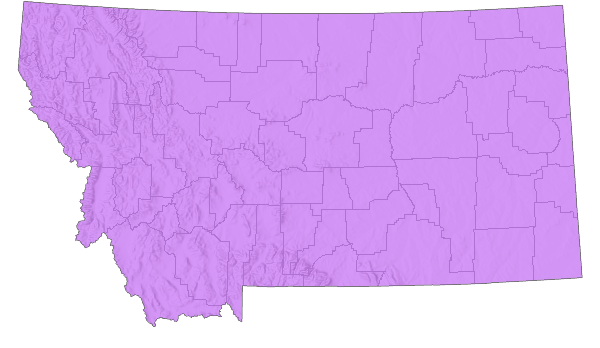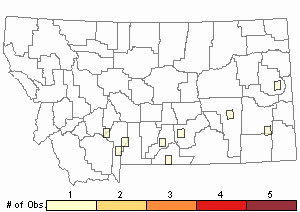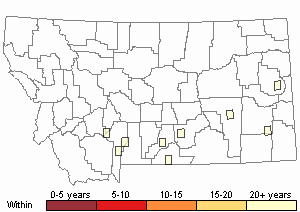View in other NatureServe Network Field Guides
NatureServe
Montana
Utah
Wyoming
Idaho
Wisconsin
British Columbia
South Carolina
Yukon
California
New York
Wrangler Grasshopper - Circotettix rabula
General Description
The following is taken from Hebard (1928), Brooks (1958), Helfer (1971), Otte (1981), Capinera and Sechrist (1982), Vickery and Kevan (1985), McDaniel (1987), Capinera et al. (2004), Brust et. al. (2008), and Scott (2010). The body is large and gray to grayish brown in color. The forewings (tegmina) are speckled with dark spotting, sometimes coalescing into faint bands and darker at the base. The hind wing possesses two enlarged veins, the disk is yellow (sometimes faint) with a dark crossband that is usually broken, but in some populations, it can be nearly complete. The apex is clear. The inner face of the hind femur is black and yellow with a black stripe ventrally. The hind tibia is yellow, sometimes brownish, or bluish.
Communicative behavior/Crepitation*:
This species produces the loudest flight crepitation noise of all known grasshoppers, which can be heard from >1300 feet (a quarter-of-a-mile). The flights are fast. somewhat erratic and last longer than those of the other Circotettix species, up to 5 or 6 minutes. They also fly higher than others, from a few feet to 30 feet above the ground, hovering over one area. The crepitations are not continuous but broken into bursts of varying durations. During courtship, the males stridulate with only one femur at a time and do not perform femur-tipping, which is used only in aggressive encounters with other males (Otte 1970 and 1981, and Vickery and Kevan 1985).
*Crepitation is the sound produced by grasshoppers making a clicking or snapping noise with their wings when in flight, during courtship, territorial encounters or being disturbed.
Phenology
This species overwinters in the egg stage. Adults occur from late June through September, sometimes into early October (Otte 1981, Vickery and Kevan 1985, Capinera et al. 2004, and Scott 2010).
Diagnostic Characteristics
The following comes from Brooks (1958), Otte (1981), Capinera and Sechrist (1982), Vickery and Kevan (1985), McDaniel (1987), Capinera et al. (2004), Brust et al. (2008), and Scott (2010). The male body length is 30-40 mm, and females 34-49 mm.
In Montana, the Wrangler Grasshopper can visually and by crepitation be confused with any of the other two
Circotettix species, the
Carlinian Snapper Grasshopper (
C. carlinianus) and the
Undulant-winged Grasshopper (
C. undulatus), as well with the
Carolina Grasshopper (
Dissosteira Carolina) and
Crackling Forest Grasshopper (
Trimerotropis verruculata).
Species Range
Montana Range
Range Descriptions

 Native
Native
Range Comments
This is the more frequently encountered and widely distributed Circotettix species in Montana. It occurs in the North from south-central British Columbia, eastward across the Canadian Provinces to south-west Manitoba, then southward through Montana, Idaho, Utah, and the northern half of Arizona, and eastward along a line from the Panhandle of Texas, Oklahoma, and the Great Plains states to North Dakota. In Montana, this species has been reported for 16 counties (Otte 1981, Vickery and Kevan 1985, Capinera et al. 2004, and Scott 2010).
Observations in Montana Natural Heritage Program Database
Number of Observations: 10
(Click on the following maps and charts to see full sized version)
Map Help and Descriptions
Relative Density

Recency


 (Observations spanning multiple months or years are excluded from time charts)
(Observations spanning multiple months or years are excluded from time charts)
Habitat
Favors sparsely vegetated rocky hillsides, eroded areas, river and stream banks, road cuts, and grassland steppes. It can be found in habitats from the low-lying plains into the higher elevated plant zones of pine and spruce (Otte 1981, Vickery and Kevan 1985, Capinera et al. 2004).
Food Habits
This is a mixed feeder on forbs and mosses, preferring loco, vetch, sandwort and bladderpod (Capinera and Sechrist 1982).
Reproductive Characteristics
Females oviposit on bare soil in flat areas or rolling open hills, and deposits 30 eggs per pod, arranged in three or four columns. The eggs are pale yellow, and about 5 mm long and 1 mm in diameter. The nymphs hatch in May to mid-June and pass through 5 instars to the adult stage (Capinera and Sechrist 1982).
Stewardship Responsibility
References
- Literature Cited AboveLegend:
 View Online Publication
View Online Publication Brooks, A.R. 1958. Acridoidea of Southern Alberta, Saskatchewan, and Manitoba (Orthoptera). The Canadian Entomologist (Supplement 9) 90:5-92.
Brooks, A.R. 1958. Acridoidea of Southern Alberta, Saskatchewan, and Manitoba (Orthoptera). The Canadian Entomologist (Supplement 9) 90:5-92. Brust, M.L, W.W. Hoback, and R.J. Wright. 2008. The Grasshoppers of Nebraska. Lincoln, NB: University of Nebraska Extension Service, APHIS.
Brust, M.L, W.W. Hoback, and R.J. Wright. 2008. The Grasshoppers of Nebraska. Lincoln, NB: University of Nebraska Extension Service, APHIS. Capinera, J.L. and T.S. Sechrist. 1982. Grasshoppers of Colorado: Identification, Biology, and Management. Fort Collins, CO: Colorado State University Experiment Station, Bulletin 584S. 161 p.
Capinera, J.L. and T.S. Sechrist. 1982. Grasshoppers of Colorado: Identification, Biology, and Management. Fort Collins, CO: Colorado State University Experiment Station, Bulletin 584S. 161 p. Capinera, J.L., R.D. Scott, and T.J. Walker. 2004. Field Guide to Grasshoppers, Katydids, and Crickets of the United States. Ithaca, NY. Cornell University Press.
Capinera, J.L., R.D. Scott, and T.J. Walker. 2004. Field Guide to Grasshoppers, Katydids, and Crickets of the United States. Ithaca, NY. Cornell University Press. Hebard, M. 1928. The Orthoptera of Montana. Proceedings of the Academy of Natural Sciences of Philadelphia, Vol. 80:211-306.
Hebard, M. 1928. The Orthoptera of Montana. Proceedings of the Academy of Natural Sciences of Philadelphia, Vol. 80:211-306. Helfer, J.R. 1971. How to Know the Grasshoppers, Crickets, Cockroaches, and Their Allies. Revised edition (out of print), Mineola, NY: Dover Publications.
Helfer, J.R. 1971. How to Know the Grasshoppers, Crickets, Cockroaches, and Their Allies. Revised edition (out of print), Mineola, NY: Dover Publications. McDaniel, B. 1987. Grasshoppers of South Dakota. Brookings, SD: South Dakota Agricultural Experiment Station, Bulletin TB 89.
McDaniel, B. 1987. Grasshoppers of South Dakota. Brookings, SD: South Dakota Agricultural Experiment Station, Bulletin TB 89. Otte, Daniel. 1970. A comparative study of communicative behavior in grasshoppers. Miscellaneous Publications, Museum of Zoology, No. 141. Ann Arbor, MI: University of Michigan.
Otte, Daniel. 1970. A comparative study of communicative behavior in grasshoppers. Miscellaneous Publications, Museum of Zoology, No. 141. Ann Arbor, MI: University of Michigan. Otte, Daniel. 1981. The North American Grasshoppers. Volume 1. Acrididae (Gomphocerinae and Acridinae). Harvard University Press. 275 pp.
Otte, Daniel. 1981. The North American Grasshoppers. Volume 1. Acrididae (Gomphocerinae and Acridinae). Harvard University Press. 275 pp. Scott, R.D. 2010. Montana Grasshoppers, Katydids, and Crickets A Pictorial Field Guide to the Orthoptera. MagpieMTGraphics, Billings, MT.
Scott, R.D. 2010. Montana Grasshoppers, Katydids, and Crickets A Pictorial Field Guide to the Orthoptera. MagpieMTGraphics, Billings, MT. Vickery, V. R. and D. K. M. Kevan. 1985. The grasshopper, crickets, and related insects of Canada and adjacent regions. Biosystematics Research Institute, Ottawa, Ontario. Publication Number 1777. 918 pp.
Vickery, V. R. and D. K. M. Kevan. 1985. The grasshopper, crickets, and related insects of Canada and adjacent regions. Biosystematics Research Institute, Ottawa, Ontario. Publication Number 1777. 918 pp.
- Additional ReferencesLegend:
 View Online Publication
View Online Publication
Do you know of a citation we're missing? Anderson, N.L. 1962. Grasshopper-vegetation relationships on Montana grasslands. Ph.D Dissertation. Bozeman, Montana: Montana State University. 73 p.
Anderson, N.L. 1962. Grasshopper-vegetation relationships on Montana grasslands. Ph.D Dissertation. Bozeman, Montana: Montana State University. 73 p. Gillespie, R.L.1992. Dynamics of grasshoppers (Orthoptera: Acrididae) at a rangeland-crop interference. Ph.D. Bozeman, MT: Montana State University. 111 p.
Gillespie, R.L.1992. Dynamics of grasshoppers (Orthoptera: Acrididae) at a rangeland-crop interference. Ph.D. Bozeman, MT: Montana State University. 111 p. Otte, Daniel. 1984. The North American Grasshoppers Volume II. Acrididae (Oedipodinae). Harvard University Press. 366 pp.
Otte, Daniel. 1984. The North American Grasshoppers Volume II. Acrididae (Oedipodinae). Harvard University Press. 366 pp. Skinner, K.F. 1995. Plant and grasshopper community composition: indicators & interactions across three spatial scales. M.Sc. Thesis. Bozeman, MT: Montana State University. 144 p.
Skinner, K.F. 1995. Plant and grasshopper community composition: indicators & interactions across three spatial scales. M.Sc. Thesis. Bozeman, MT: Montana State University. 144 p.
- Web Search Engines for Articles on "Wrangler Grasshopper"
- Additional Sources of Information Related to "Insects"





